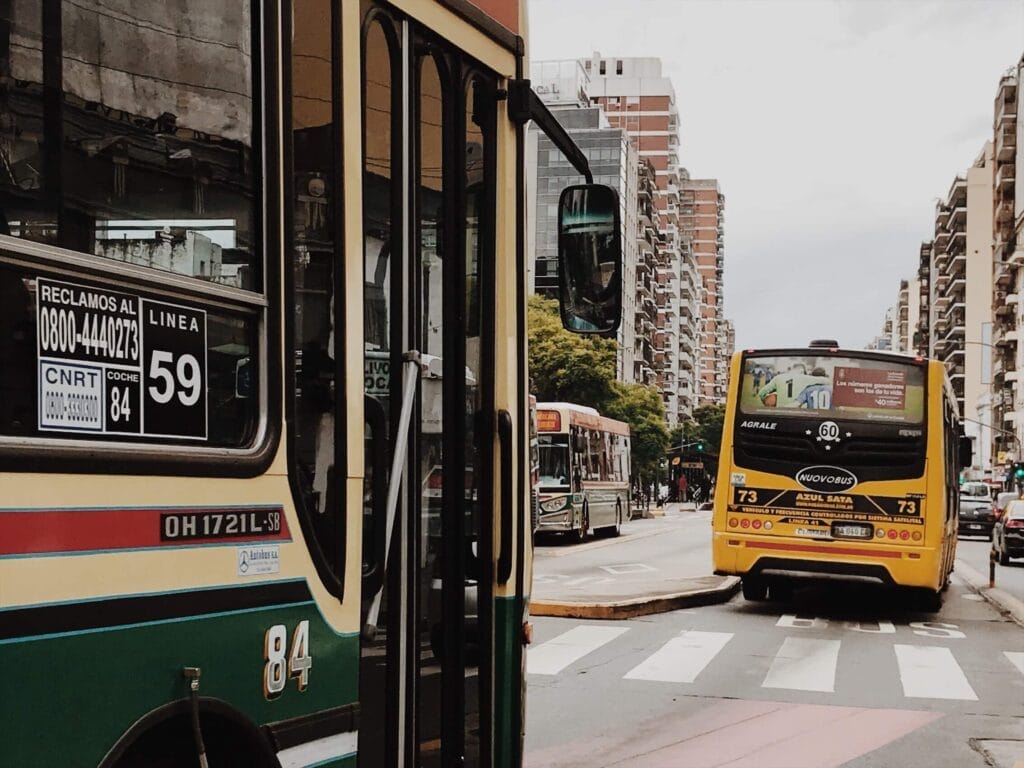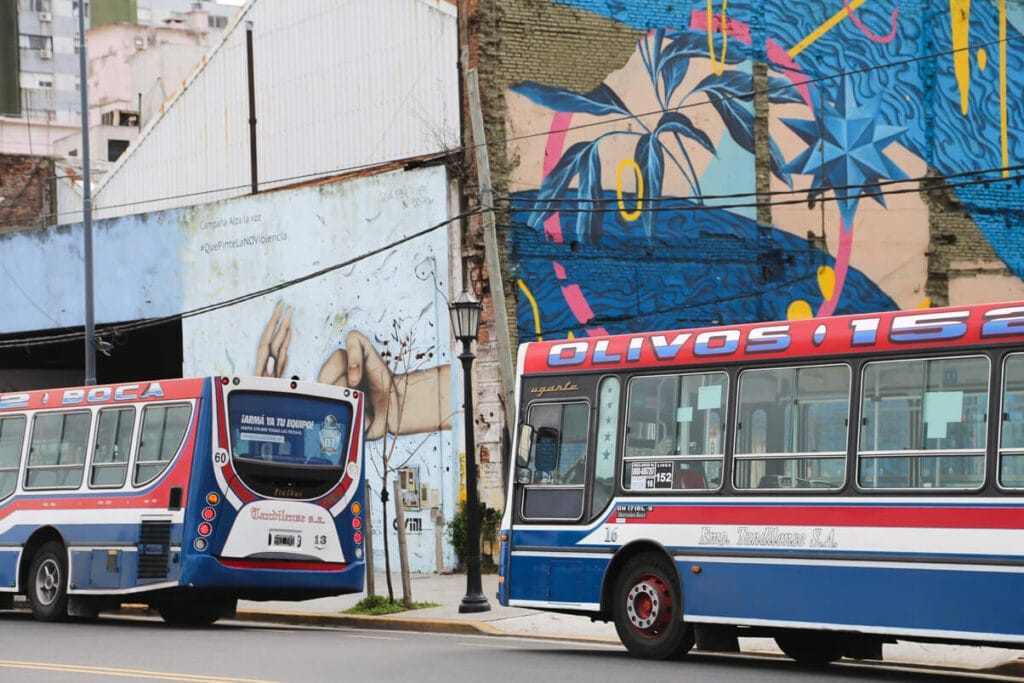There are two type of travelers, those who will only take public transportation in a new city and those thriving with Uber.
In Buenos Aires the public transportation can feel very intimidating.
But, without a doubt, it’s the best way to get around and I promise it’s not as difficult as it looks.
Will you get lost? Maybe.
But in these days of apps and iPhones, I’d say you’ll come out the the other side just fine.
Ready to give it a try?
Here’s a step by step guide to conquering Buenos Aires public transportation.

QUICK NOTE: This post contains affiliate links and Sol Salute may receive a commission for purchases made through these links, at no extra cost to you.
How to Conquer Public Transportation in Buenos Aires
Step 1: Get a SUBE Card

You cannot use any public transportation in Buenos Aires without a SUBE card UPDATED BELOW 👇🏻
Buses don’t take cash and trains don’t issue tickets, you’ll use your SUBE.
SUBE UPDATE 2025: The monopoly of the SUBE seems to be ending (source). After years of only being able to purchase tickets on public transportation with the SUBE, they are finally changing the system to allow for other methods of payment.
As of December 2024, the SUBTE underground system allows for payments (on the new turnstiles) with Visa & Mastercard debit and credit cards and virtual wallets like Gpay, ApplePay, MODO, among others.
The SUBE card is still required for other modes of transportation – like colectivos/city buses – until the roll out is complete later in 2025, TBD.
It is still vital to have a SUBE so where to get one? They’re sold in subway and train station ticket booths and in some kioscos (like mini convenience stores) all over the city. The tourism board claims you can buy it online here (I have not put this to the test).
You’ll have to put in some leg work and ask around. They’re not free but at only 880 pesos (as of December 2024), it practically is.
Once you have it, load your cash onto it (also in subway or train stations or and you’re ready to go.
Step 2: Use Moovit or Google Maps


I used to recommend an app here called Como Llego, unfortunately the city government stopped investing in updates for it two years ago.
Now the best apps to use to navigate public transportation in Buenos Aires and to figure out your routes are the same ones you’d use elsewhere.
Moovit and Google Maps are both great options that will map out your routes via bus, train, subte, bike, or walking.
Step 3: Start easy, take the Subte

The subte (short for subterráneo or underground) is the easiest place to start.
You can’t get lost.
Line D is a great option to begin with, starting in Plaza de Mayo and going to plenty of highlights like Teatro Colon (Estación Tribunales), Recoleta, and Palermo.
Line B is another good alternative running from downtown to Calle Florida and the Obelisk and all the way to Almagro and Abasto.
For a historic experience, Line A begins in Plaza de Mayo and runs underneath Avenida Rivadavia to Congress and beyond.
Fun fact, Line A is the oldest subway line in the southern hemisphere! But sadly, the historic wooden cars have been replaced by modern ones. They are admittedly more spacious and practical but lack the historic charm.
Step 4: Be brave, Take the Bus

Colectivos are the best way to get around Buenos Aires.
It’s easy to be intimidated by the bus, since it’s a bit easier to get lost this way.
However, taking the city’s many colectivos was my favorite way to get to know the city when I first moved here in 2010. You can actually see where you’re going above ground and learn the city properly.
Did I get lost? Definitely.
But that was also a bit of the fun.
Colectivo Road Map For Success: Start with ONE bus at a time. This is your bus. Take it, learn it, love it. When you’re comfortable with the route and where it takes you. Add in another.
BUS TIP: Start with quiet times of the day and avoid rush hour. When the bus is pretty empty, the driver is available to lend you a hand. Ask him to tell you when you’re at your stop and stay close to the front so he can see you. You’d be surprised how many are willing to help.
Best Starter Bus? The 152. If you’re in an expat or tourist, you’re probably in San Telmo, Recoleta, Palermo, or Belgrano (probably), and if you aren’t staying there, you’re going there.
The 152 connects all the best things to do in Buenos Aires, starting right by Caminito in La Boca before passing San Telmo, Puerto Madero, Plaza de Mayo/Microcentro, Retiro, Recoleta, Palermo, and Belgrano before jetting off into Zona Norte suburbs.
This bus will undoubtedly take you where you need to go and it runs with very high frequency.
Step 5: Don’t Neglect the Trains

The trains here are an excellent facet of the Buenos Aires public transport that I feel don’t get enough love from visitors.
The most common interaction a tourist has with the trains is a day trip to Tigre or maybe the Tren de la Costa.
Both are great ways to use the train here, turning an otherwise pricey organized tour into a cheap DIY day out.
But you can use the train even more than that, connecting from Retiro or Belgrano to the Bosques de Palermo (one of the most beautiful parks in Buenos Aires). Or you can get from Palermo to downtown in just 15 minutes.
The trains are great! Don’t neglect them.
Read more in my guide to all things trains in Argentina.
Step 6: When All Else Fails, Taxi
If you get lost, hail a cab.
If you’re just too tired, too confused, or it’s too late at night to risk it, take a cab.
Taxis are everywhere in Buenos Aires. The yellow and black radio taxis are safe to take.
You can also use ride sharing apps like Uber or Cabify.
Taxis and Ubers are so cheap (compared to the US and Europe) that it isn’t shameful to rely on here and there (or even most of the time).
Buenos Aires Public Transport: A Summary
I hope you now feel confident to go out there and take the bus, or at the very least, the subte.
It’s honestly not as scary as it sounds.
You’ll save quite a few pesos and have a good time doing it.
Seriously, nothing beats the people watching on the bus.
Read More About Buenos Aires
- Money in Argentina: Currency Exchange Guide
- The Perfect 3 Days in Buenos Aires Itinerary
- Things to do in Buenos Aires When it Rains
- 11 Traditional Buenos Aires Food Experiences
- The Best Buenos Aires Bike Tours
Argentina Travel Resources
- BOOK A CONSULTATION | I offer one-on-one travel consultations to help you plan your trip to Argentina. Pick my brain to get a local’s insight. Click here for more information.
- MY MAP | Buy my interactive map with 300+ pins to have access to the city as I see it. It is an invaluable resource. See more here about how it works.
- AIRPORT TRANSFERS | Having a driver waiting for you is ideal for a stress free arrival, Cesar and his team here is the best option for a driver from Ezeiza or Aeroparque, they are my go-to airport ride!
- TRAVEL INSURANCE | Always travel insured. Anything can happen anywhere and it is scarier and costlier in an unfamiliar country. SafetyWing’s Essential Plan covers unexpected travel and medical emergencies and even offers add-ons like electronics theft or adventure sports. It is the best if you’re coming on vacation. If you’re coming as a digital nomad or an extended stay, you need their Complete Nomad Plan which also covers routine check ups, maternity, mental healthcare and more. Read more: Health Insurance in Argentina
- PHONE PLAN | These days, traveling with data is essential. Especially in Argentina where everything is managed on Instagram and WhatsApp. I recommend this E-SIM card. It’s hassle-free and affordable, for more read how to get an Argentina sim card.
- ACCOMMODATION IN ARGENTINA | booking.com is the most common hotel site used in Argentina and it’s where you’ll find the most options.
- RENTAL CARS | I love using Discover Cars, it is a great platform to compare different rates and providers and I find they have responsive customer service.
- BUS TICKETS | Check Busbud for long distance bus routes and tickets.
- VPN | If you’ll be using a public WiFi connection and want to secure your data, I highly recommend using a VPN, I personally use and have had a good experience with ExpressVPN. I also use it to access Hulu and American Netflix from Argentina.
- FLIGHTS | Always check Google Flights and Skyscanner for flights to and within Argentina. Aerolineas Argentina is the local airline with the most routes. FlyBondi and Jetsmart are two budget airlines with dirt-cheap prices (but expect to pay for every add-on like luggage).


Hi Erin,
Thank you for useful information!
Could you please tell me what is the status of Uber in BA these days? Is it legal and safe, because I found contradictory information about it.
Best,
Maja